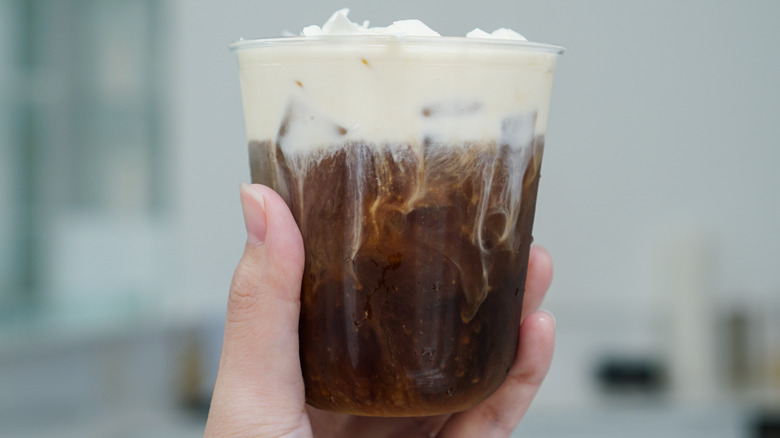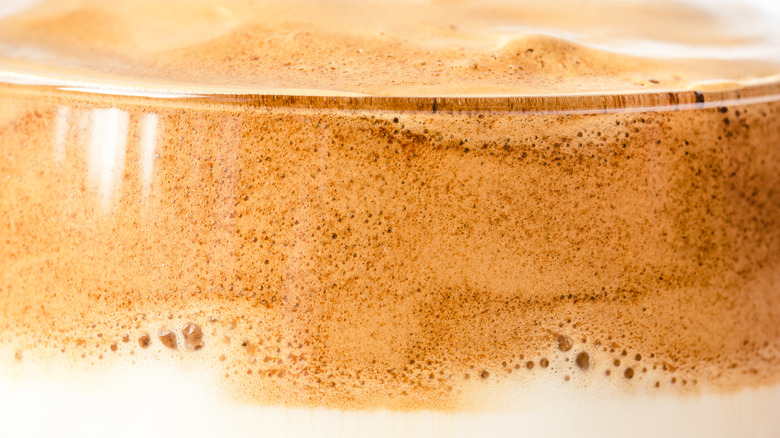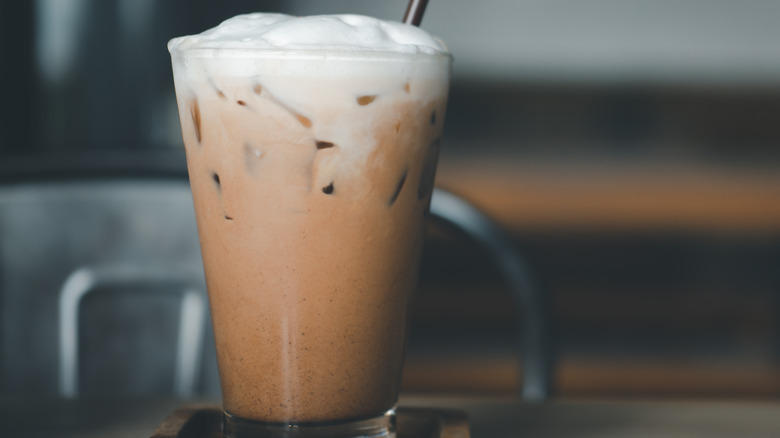Barista Tips For Adding Cold Foam To Iced Coffee
Whether it's an egg white cocktail at happy hour, a morning cappuccino, or a mid-day cold brew topped with foam, it feels undeniably decadent to sip on something frothy. Although more people are stepping into their making coffee at home era, the idea of "treating oneself" remains alive, and folks continue learning how to make coffee recipes that put a standard cup of coffee to shame. When done right, cold foam is the sweet and frothy crown jewel of homemade java additions. "I love cold foam," Onyx Coffee Lab co-founder and co-owner Andrea Allen tells Mashed, adding, "It's tasty; it creates beautiful drinks and a canvas for colors and flavors — such a cool element in drinks."
As the 2020 U.S. Barista Champion and the 2021 World Barista Champion runner-up, Allen has a deep well of knowledge on the subject of coffee and crafting it. According to her, achieving perfectly textured cold foam comes down to "fat content and shaking/texturing to get appropriate air pockets into the foam." Allen explains that the flavor and fat content of your milk should be a primary consideration. "If you're using non-dairy, you have to have some fat base in order to make thick, rich foam," she suggests, adding, "Ingredients like coconut cream are great and can be useful for both dairy and non-dairy cold foams."
What's your cold foam flavor?
The trick to making Starbucks-worthy cold foam at home is finding the right tools. While hot coffee drinks, like lattes, are made with a steam wand that works to simultaneously heat and aerate the milk, cold foam is aerated by agitating it. "If you're using a shaker with a shaker ball, you have to commit to doing the amount of shaking that it takes," Andrea Allen tells Mashed. When making your cold foam manually, a protein shaker bottle, cocktail shaker tin, or a mason jar with a lid can all be effective tools. Meanwhile, the shaker ball works like a whisk, incorporating more air into the mixture. "There's also the hand-held frothers that are incredible and work great," she points out.
Cold foam can provide your drink with more than just a creamy texture — it can also work to incorporate sweetness and new flavor combinations. "The way to add flavor and color is to add a little bit of syrup, honey, or sweetener," says Allen. Blending in an ounce or two of homemade simple syrup flavored with lavender flowers, vanilla extract, or pumpkin purée can transform your cold foam into a seasonal treat. "I'm a big fan of powders: matcha, spirulina, beetroot powder, strawberry powder," Allen offers, adding, "things like that make great colors and flavors."
Keep it cold — it's in the name!
Perhaps equally as important to the taste of your favorite coffee drink is the way in which it's presented to you. Because we eat first with our eyes, if your homemade cold foam doesn't look as velvety as the one from your favorite coffee shop, it's unlikely you'll find it tastes any better, either. While you may have seen some baristas spoon cold foam atop your drink in order to achieve towering heights, Andrea Allen says, "I personally like to pour it." While she says thicker cold foams may warrant scooping (or squeezing, if you're using store-bought canned cold foam), Allen believes this method doesn't "feel as cohesive" as those that have had the foam poured over the top. "If the consistency is right, the foam will pour out nice and thick, but [will] also settle nicely on top of the drink."
The temperature of the cold foam is also a key factor in achieving a beautifully layered beverage. "If the foam and the drink are the same temperature, then the foam won't float, and it'll get pretty mixed up," Allen explains. Although cold foam poured over a hot drink will still taste delicious, it won't have the same visual effect as when it's suspended on top of an iced beverage. She recommends keeping your cold foam at a temperature between 45 and 55 degrees Fahrenheit, a range that keeps the foam "cold enough to be cold but warm enough to pour."


